
March 05, 2009
Homeschool
Seeker
Volume #002
February 2009
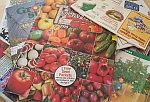
In
this issue
- Introduction
- Sponsor ad
- Website updates
- Science Mini Lapbook
- Tip of the month
- Sponsor ad
- Homeschool Picture of the month
- Homeschool Question/Answer
- Wishlist
- Closing Comments
Introduction
Welcome to the
current issue of
The Homeschool Seeker. I apologize that this issue
is late. We have been having problems with our
phone/internet connections. Regardless, I hope you
enjoy this issue and rest assured the next issue
will be on time.
Science is a fascinating subject that often sparks debate.
Science is about discovery and trying to understand what
those discoveries mean for us and for the future of earth.
It is also about facts and truth.
Learning about ourselves and our world and the
environment should not be at odds with our faith but
at the same time we should uphold moral standards
that protect life not just those that preserve it.
The study of science can help us care for ourselves,
our children our environment and all those things
entrusted into our care.
Can we can care for something we do not understand?
Probably, but not very well. The discipline of science
is worthy of our attention.
In this newsletter, we will not be discussing
or debating Science research, nor will I impose my
personal beliefs into the facts. Instead, we will
look at Science as a necessary topic to study and
deal with facts as we know them.
As a discipline of research and as we discover more,
we understand more and thus our awe of all creation
is magnified.

Website
Updates
Last month I reported that I would
be removing the Used Books sections.
That is still in the works. In February, I spent a great deal of time
trying to figure out what is best for my visitors
and what they might want. Therefore, I did not make
any big changes. Currently, I am considering many
different projects but I am not ready to announce
what those projects will be but I believe they will
be very helpful to you, whether you are a veteran
homeschooler or a new homeschooler.
Via this newsletter, I will keep you informed of any
big additions to the site.
Feature
Mini Lapbook
This month's
feature mini lapbook is on Science. Last month,
I picked a very general topic: Basic Math.
So this month I wanted to show you how you can use Mini
Lapbooks for a very specific topic and how to use it
as a study tool for more advanced courses.
The topic is from a Biology course and it is about
Hierarchical Organization.
In most Science classes, the student will find that
there are many cycles, orders, paths, terms and
techniques. Each of these can be made into a mini
lapbook which will then reinforce the main ideas and
concepts and terms in a quick to review format.
Encouraging your students to review the mini
lapbooks on a daily basis will keep the information
fresh in their minds and actually help them
retain the information.
Here's how I created this mini
lapbook.
1. Gather supplies
Supplies you will need for this mini lapbook:
- 3 brown paper lunch bag
- hole punch
- yarn or string or other material to finish
construction of lapbook
- markers, coloring crayons, pencils,
pens
Optional Supplies:
- Stencils
- Art supplies
- stickers
- glitter
- glue
- scissors
- Biology book or Life Science books
2. Once you have all your supplies, fold the 3 paper
bags in 1/2 and hole punch the edges.
For more pictures on how this will look and basic
assembly you can visit Mini Lapbooks
3. Begin by decorating cover. Give the mini lapbook
a title. I will use Hierarchical Organization
for my title.
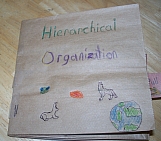
4. Choose concepts: For this mini lapbook,
I want to demonstrate the different levels of
hierarchical organization of life in a visual manner.
From the same chapter in the biology book I am
using for a reference other concepts that could
also be used for a mini lapbook are:
a)Biology: Study of life, careers,tools, research
techniques
b)Living things: Characteristics of a living organism
c)Cells: Differences between animal and plant cells
d)Homeostasis cycle
e)Metabolic Reactions: The process and steps
f)Theories vs Beliefs vs Facts and the processes
of logic
g)Mutations: Examples, causes, adaptations
h)Energy cycle: Producers, Consumers and Decomposers
i)Naming and Organization: Binomial System
of Nomenclature, Classification from Kingdom
through Species, examples, types of classification,
(Might include a made up system by student in an
attempt to classify a group of objects)
5. Delegate pages for each concept
With the concepts I chose:
- Cover Page
- Chemical
- Cell
- Tissue
- Organ
- Body System
- Organism
- Populations
- Community
- Ecosystem
- Ecosphere
- Making Connections
6. Label pages
7. Add information
- Chemical
Key Points to have them include or illustrate:
a)Simplest level of organization
b)The atom is the smallest amount of a chemical element
that retains the characteristic properties of that
element
c)Atoms and molecules make up the cellular level
d)Define cytoplasm
e)Define plasma membrane
f)Atoms combine chemically to for molecules
g)Example 2 atoms of Hydrogen combine with one
atom of Oxygen to form a water molecule
- Cell
Key Points to have them include or illustrate:
a)A cell consists of cytoplasm surrounded by a plasma membrane
b)Differences between plant and animal cells
c)Cytoplasm is a mixture of water and chemicals
d)Some cellular substances are organized into
special structures called organelles
e)There are many different types of cells
f)The organelle called the Nucleus contains DNA
Note:Since this is a beginning chapter, I would not
have them go to deep into any particular area yet.
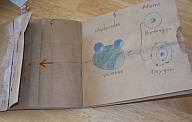
- Tissue
Key Points to have them include or illustrate:
a)In multicellular organisms similar cells associate
to form tissues
b)Examples:Heart tissue, muscle tissue, lung tissue, bone
tissue etc.
- Organs
Key Points to have them include or illustrate:
a)Tissues are further arranged into specialized
functional structures
b)Examples: Heart, Bone, Lungs, Brain etc.
If you wish to further examine or study organs,
SEAN has hands-on models and products that are
good. (see link below)
As a side note: I did find some really cheap models of the body/brain at a local Dollar Store.
Biology - From test kits to Darwin
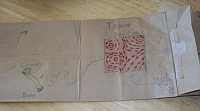
- Body Systems
Key Points to have them include or illustrate:
a)Biological functions, grouped and working together
for organ systems
b)Examples: Circulatory system, Nervous system, Skeletal
System
- Organism
Key Points to have them include or illustrate:
a)Working together, these elements,
from the chemical to the organ systems, create
and form a complex organism.
b) Example: Human Being
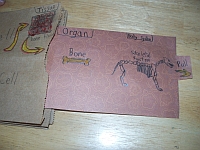
- Populations
Key Points to have them include or illustrate:
a)This is a higher category of organization
b)Members of a species are not uniformly
scattered over the earth
c)Found in groupings called Populations
d)Inhabit specific regions
If you wish to have them study populations further
one idea I've never been brave enough to try is
having an ant farm. Here is a link to a place online
where you can purchase one if you dare.
Not for me though. :)
Giant Ant Farm Kit - introduce children to the fascinating structure of ant society.
- Community
Key Point:
Various populations of different species that
interact together form a Community.
From the same place above you can find Butterfly
Garden Kits to help illustrate in a hands-on
way the concepts of growth and development extending
into the level of community.
Butterfly Garden Kit - five tiny caterpillars turn into beautiful painted lady butterflies right before your eyes.
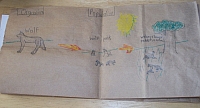
- Ecosystem
Have them illustrate or make tiny info
fact checkers.
Key points to include:
a) Ecosystem consists of three varieties of organisms
b) Producers
c) Consumers
d) Decomposers
e) Each of these has an appropriate physical environment
for their survival
- Ecosphere
Key Points
a) The ecosphere is the largest ecosystem
b) self-sustaining
c) planet Earth
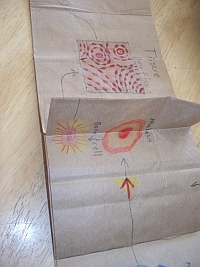
- Making Connections
The final page hasn't been finished yet on our
copies of this mini lapbook but what I will have
my children add onto this back page is something
that makes a connection with this material to their
lives.
It might be simply having them get a picture of
the earth and pinpointing where they live.
Other ideas:
a)Make a one page visual of them in the organization
chart.
b)Have them illustate where they think they fit in the
hierarchical system
c)Gather and paste in pictures of different
communities or populations in which they are active

8. Review information
I can not stress enough the importance of
repeated review. When I say repeated review
I want to clarify what I mean. I mean, on the
first day review upon completion and then
perhaps once or twice more throughout the
day...making it fun and stress free as possible.
Then repeat on the 2nd day and finally once a
day until they are confident they know the material.
9. Add finishing details and final assembly
Decorate the mini lapbook with art crafts
and supplies. Assemble by sewing or attaching
the bags together.
While I haven't included a picture of our completely
assembled mini lapbook. I do want you to consider
how my son finished his as an alternative method of
assembly. Instead of connecting through the holes,
he taped ends together and folded them in.
See picture above.
There are no strict rules here. Let them be creative in
all the aspects from decorating to assembly.
Tip of
the Month
Science Tip of the
Month: Avoid watering down the material.
I found it very discouraging to teach science year
to year by using science textbooks. The reason being
that the material started so basic for the children
with very little opportunity to challenge or excite
them about science.
I found it was better to use books from the library
or magazines that cater to science subjects for children.
An example would be Kids Discover magazine-though the
magazine covers many different subjects.
Therefore, if your child seems to be bored with science,
try checking out a few topic specific books that are just at
or above your child's level of understanding. The key
is to not make it too easy but not too hard either.
Then add in some science experiments. Below I recommend
a few books that you can find from either the library or
online.
Also, if you want your child to know the proper terminology,
then use the proper terminology from the start.
Don't ever feel that you have to keep it simple to help
them understand...you actually want them to learn...so
introduce new terms even if they seem too high for their
age level.
Sponsor ad
*************

*************
Homeschool
Picture of the Month
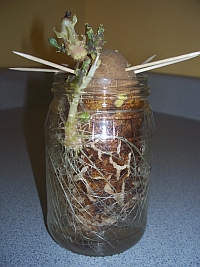
This picture illustrates what happens when homeschool
science experiments go awry.
My daughter started this experiment with a
somewhat large potato and when it started
sprouting it became difficult to remove the
potato from the jar in order to continue the
experiment.
It is currently still in the jar but we plan
to cut it into pieces and plant them either
when the weather warms up or in our aquaponics system.
Science experiments are fun for the kids
and there are many books and resources available
through the library and bookstores.
The experiments are great for exploring
the concepts and often the hands-on element
helps them learn better.
A good science experiment book for younger children
is by Janice VanCleave. It gives short experiments
and easy to understand explanations. This is one book
of a whole series-all of them are similar to this example.
If you prefer to order online, you can find it at
Amazon through the following link
While trying to locate this book reference at Amazon,
I found a few more interesting science books that you
might want to check out for different age levels.
If you would like to send a picture to be considered
for use in The Homeschool Seeker there are several
places on the website where you can submit the image.
However, the best place to submit an image for the newsletter would be at
Kid's Create
Just please add title HOMESCHOOL SEEKER PICTURE so
that I know it is not a Kid's creation submission.
Thanks.
Homeschool
Question/Answer
Question: Do you have any tips for helping the
students remember facts and important concepts, for
example from their science lessons?
Answer:
Just recently, I rediscovered a technique
for studying that works beautifully for subjects
like science and history.
******************************************************************
Read, Ask, Write
This method has proven to be incredibly effective
in our homeschool.
1. Basically, have them read for a short amount of
time...5, 10 or 15 minutes the material you are wanting
them to learn or study.
2. Then have them come up with three questions for
every 5 minutes of time they read, from the material they
just read.
If they read 5 minutes: Write and answer 3 questions.
10 minutes: Write and answer 6 questions.
At first you might need to guide them into picking out
the key ideas and what might be a good question related
to that concept.
3. Have them write down the questions and the answers.
4. At the end of each session give them a break or
a mini reward.
5. Repeat the process until finished with the complete
lesson or section.
6. Review questions/answers a couple of times per day
the first day. Then once a day for about a week.
Then test them on the key concepts/ideas.
Homeschool
Wishlist
I really want
to make this a newsletter
you enjoy reading. So if you have ideas,
comments
or suggestions please visit Homeschool Wishlist
Closing
Comments
I hope you
enjoyed this issue of
The Homeschool Seeker.
Until next time, happy
homeschooling!
JulieD
February 2009

- Introduction
- Sponsor ad
- Website updates
- Science Mini Lapbook
- Tip of the month
- Sponsor ad
- Homeschool Picture of the month
- Homeschool Question/Answer
- Wishlist
- Closing Comments
Introduction
The Homeschool Seeker. I apologize that this issue
is late. We have been having problems with our
phone/internet connections. Regardless, I hope you
enjoy this issue and rest assured the next issue
will be on time.
Science is a fascinating subject that often sparks debate.
Science is about discovery and trying to understand what
those discoveries mean for us and for the future of earth.
It is also about facts and truth.
Learning about ourselves and our world and the
environment should not be at odds with our faith but
at the same time we should uphold moral standards
that protect life not just those that preserve it.
The study of science can help us care for ourselves,
our children our environment and all those things
entrusted into our care.
Can we can care for something we do not understand?
Probably, but not very well. The discipline of science
is worthy of our attention.
In this newsletter, we will not be discussing
or debating Science research, nor will I impose my
personal beliefs into the facts. Instead, we will
look at Science as a necessary topic to study and
deal with facts as we know them.
As a discipline of research and as we discover more,
we understand more and thus our awe of all creation
is magnified.
Website Updates
be removing the Used Books sections.
That is still in the works.
In February, I spent a great deal of time
trying to figure out what is best for my visitors
and what they might want. Therefore, I did not make
any big changes. Currently, I am considering many
different projects but I am not ready to announce
what those projects will be but I believe they will
be very helpful to you, whether you are a veteran
homeschooler or a new homeschooler.
Via this newsletter, I will keep you informed of any
big additions to the site.
Feature Mini Lapbook
I picked a very general topic: Basic Math.
So this month I wanted to show you how you can use Mini
Lapbooks for a very specific topic and how to use it
as a study tool for more advanced courses.
The topic is from a Biology course and it is about
Hierarchical Organization.
In most Science classes, the student will find that
there are many cycles, orders, paths, terms and
techniques. Each of these can be made into a mini
lapbook which will then reinforce the main ideas and
concepts and terms in a quick to review format.
Encouraging your students to review the mini
lapbooks on a daily basis will keep the information
fresh in their minds and actually help them
retain the information.
Here's how I created this mini
lapbook.
1. Gather supplies
Supplies you will need for this mini lapbook:
- 3 brown paper lunch bag
- hole punch
- yarn or string or other material to finish construction of lapbook
- markers, coloring crayons, pencils,
pens
Optional Supplies:
- Stencils
- Art supplies
- stickers
- glitter
- glue
- scissors
- Biology book or Life Science books
2. Once you have all your supplies, fold the 3 paper
bags in 1/2 and hole punch the edges.
For more pictures on how this will look and basic
assembly you can visit Mini Lapbooks
3. Begin by decorating cover. Give the mini lapbook
a title. I will use Hierarchical Organization
for my title.

I want to demonstrate the different levels of
hierarchical organization of life in a visual manner.
From the same chapter in the biology book I am
using for a reference other concepts that could
also be used for a mini lapbook are:
a)Biology: Study of life, careers,tools, research
techniques
b)Living things: Characteristics of a living organism
c)Cells: Differences between animal and plant cells
d)Homeostasis cycle
e)Metabolic Reactions: The process and steps
f)Theories vs Beliefs vs Facts and the processes
of logic
g)Mutations: Examples, causes, adaptations
h)Energy cycle: Producers, Consumers and Decomposers
i)Naming and Organization: Binomial System
of Nomenclature, Classification from Kingdom
through Species, examples, types of classification,
(Might include a made up system by student in an
attempt to classify a group of objects)
5. Delegate pages for each concept
With the concepts I chose:
- Cover Page
- Chemical
- Cell
- Tissue
- Organ
- Body System
- Organism
- Populations
- Community
- Ecosystem
- Ecosphere
- Making Connections
7. Add information
- Chemical
a)Simplest level of organization
b)The atom is the smallest amount of a chemical element
that retains the characteristic properties of that
element
c)Atoms and molecules make up the cellular level
d)Define cytoplasm
e)Define plasma membrane
f)Atoms combine chemically to for molecules
g)Example 2 atoms of Hydrogen combine with one
atom of Oxygen to form a water molecule
- Cell
a)A cell consists of cytoplasm surrounded by a plasma membrane
b)Differences between plant and animal cells
c)Cytoplasm is a mixture of water and chemicals
d)Some cellular substances are organized into
special structures called organelles
e)There are many different types of cells
f)The organelle called the Nucleus contains DNA
Note:Since this is a beginning chapter, I would not
have them go to deep into any particular area yet.

- Tissue
a)In multicellular organisms similar cells associate
to form tissues
b)Examples:Heart tissue, muscle tissue, lung tissue, bone
tissue etc.
- Organs
a)Tissues are further arranged into specialized
functional structures
b)Examples: Heart, Bone, Lungs, Brain etc.
If you wish to further examine or study organs,
SEAN has hands-on models and products that are
good. (see link below)
As a side note: I did find some really cheap models of the body/brain at a local Dollar Store.
Biology - From test kits to Darwin

- Body Systems
a)Biological functions, grouped and working together
for organ systems
b)Examples: Circulatory system, Nervous system, Skeletal
System
- Organism
Key Points to have them include or illustrate:
a)Working together, these elements,
from the chemical to the organ systems, create
and form a complex organism.
b) Example: Human Being

- Populations
Key Points to have them include or illustrate:
a)This is a higher category of organization
b)Members of a species are not uniformly
scattered over the earth
c)Found in groupings called Populations
d)Inhabit specific regions
If you wish to have them study populations further
one idea I've never been brave enough to try is
having an ant farm. Here is a link to a place online
where you can purchase one if you dare.
Not for me though. :)
Giant Ant Farm Kit - introduce children to the fascinating structure of ant society.
- Community
Key Point:
Various populations of different species that
interact together form a Community.
From the same place above you can find Butterfly
Garden Kits to help illustrate in a hands-on
way the concepts of growth and development extending
into the level of community.
Butterfly Garden Kit - five tiny caterpillars turn into beautiful painted lady butterflies right before your eyes.

- Ecosystem
Have them illustrate or make tiny info fact checkers.
Key points to include:
a) Ecosystem consists of three varieties of organisms
b) Producers
c) Consumers
d) Decomposers
e) Each of these has an appropriate physical environment
for their survival
- Ecosphere
Key Points
a) The ecosphere is the largest ecosystem
b) self-sustaining
c) planet Earth

- Making Connections
The final page hasn't been finished yet on our
copies of this mini lapbook but what I will have
my children add onto this back page is something
that makes a connection with this material to their
lives.
It might be simply having them get a picture of
the earth and pinpointing where they live.
Other ideas:
a)Make a one page visual of them in the organization
chart.
b)Have them illustate where they think they fit in the
hierarchical system
c)Gather and paste in pictures of different
communities or populations in which they are active

8. Review information
I can not stress enough the importance of
repeated review. When I say repeated review
I want to clarify what I mean. I mean, on the
first day review upon completion and then
perhaps once or twice more throughout the
day...making it fun and stress free as possible.
Then repeat on the 2nd day and finally once a
day until they are confident they know the material.
9. Add finishing details and final assembly
Decorate the mini lapbook with art crafts
and supplies. Assemble by sewing or attaching
the bags together.
While I haven't included a picture of our completely
assembled mini lapbook. I do want you to consider
how my son finished his as an alternative method of
assembly. Instead of connecting through the holes,
he taped ends together and folded them in.
See picture above.
There are no strict rules here. Let them be creative in
all the aspects from decorating to assembly.
Tip of the Month
I found it very discouraging to teach science year
to year by using science textbooks. The reason being
that the material started so basic for the children
with very little opportunity to challenge or excite
them about science.
I found it was better to use books from the library
or magazines that cater to science subjects for children.
An example would be Kids Discover magazine-though the
magazine covers many different subjects.
Therefore, if your child seems to be bored with science,
try checking out a few topic specific books that are just at
or above your child's level of understanding. The key
is to not make it too easy but not too hard either.
Then add in some science experiments. Below I recommend
a few books that you can find from either the library or
online.
Also, if you want your child to know the proper terminology,
then use the proper terminology from the start.
Don't ever feel that you have to keep it simple to help
them understand...you actually want them to learn...so
introduce new terms even if they seem too high for their
age level.
Sponsor ad
*************
![]()
*************
Homeschool Picture of the Month

science experiments go awry.
My daughter started this experiment with a
somewhat large potato and when it started
sprouting it became difficult to remove the
potato from the jar in order to continue the
experiment.
It is currently still in the jar but we plan
to cut it into pieces and plant them either
when the weather warms up or in our aquaponics system.
Science experiments are fun for the kids
and there are many books and resources available
through the library and bookstores.
The experiments are great for exploring
the concepts and often the hands-on element
helps them learn better.
A good science experiment book for younger children
is by Janice VanCleave. It gives short experiments
and easy to understand explanations. This is one book
of a whole series-all of them are similar to this example.
If you prefer to order online, you can find it at
Amazon through the following link
While trying to locate this book reference at Amazon,
I found a few more interesting science books that you
might want to check out for different age levels.
If you would like to send a picture to be considered
for use in The Homeschool Seeker there are several
places on the website where you can submit the image.
However, the best place to submit an image for the newsletter would be at
Kid's Create
Just please add title HOMESCHOOL SEEKER PICTURE so
that I know it is not a Kid's creation submission.
Thanks.
Homeschool Question/Answer
students remember facts and important concepts, for
example from their science lessons?
Answer: Just recently, I rediscovered a technique
for studying that works beautifully for subjects
like science and history.
******************************************************************
This method has proven to be incredibly effective
in our homeschool.
1. Basically, have them read for a short amount of
time...5, 10 or 15 minutes the material you are wanting
them to learn or study.
2. Then have them come up with three questions for
every 5 minutes of time they read, from the material they
just read.
If they read 5 minutes: Write and answer 3 questions.
10 minutes: Write and answer 6 questions.
At first you might need to guide them into picking out
the key ideas and what might be a good question related
to that concept.
3. Have them write down the questions and the answers.
4. At the end of each session give them a break or
a mini reward.
5. Repeat the process until finished with the complete
lesson or section.
6. Review questions/answers a couple of times per day
the first day. Then once a day for about a week.
Then test them on the key concepts/ideas.
Homeschool Wishlist
you enjoy reading. So if you have ideas, comments
or suggestions please visit Homeschool Wishlist
Closing Comments
The Homeschool Seeker.
Until next time, happy homeschooling!
JulieD